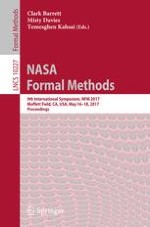This book constitutes the proceedings of the 9th International Symposium on NASA Formal Methods, NFM 2017, held in Moffett Field, CA, USA, in May 2017.
The 23 full and 8 short papers presented in this volume were carefully reviewed and selected from 77 submissions. The papers focus on formal techniques and other approaches for software assurance, their theory, current capabilities and limitations, as well as their potential application to aerospace, robotics, and other NASA-relevant safety-critical systems during all stages of the software life-cycle.
